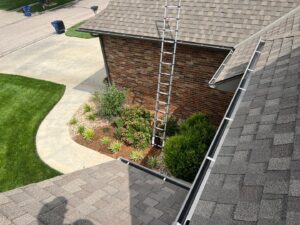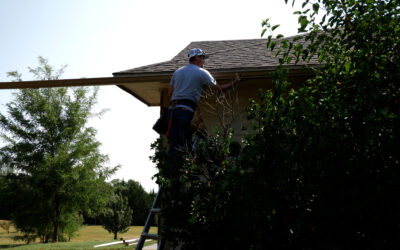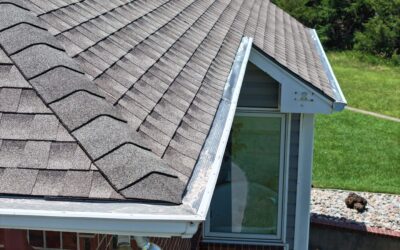Most of us don’t know what size gutters are on our homes, although we look at them every day. Gutters are usually more functional than decorative, so they are designed to blend into the house as much as possible. Unfortunately, some of us discover the hard way we have the wrong gutters installed during a downpour where waterfalls and backflows show themselves. These failures can lead to erosion around your foundation and water leaking into your attic.
As many homeowners have learned, the size, installation, and location of gutters will greatly affect their performance. For homeowners with experience unclogging gutters on a slippery roof, finding a way to reduce maintenance is a high priority.
Standard gutters, known as residential size, are 5” wide and usually drain into a 2” x 3” residential downspout. For some houses with fewer trees or just a design that allows better drainage, 5” gutters will be enough. However, there are larger sizes available which can help solve common drainage problems when the current system is not functioning properly.
Are 6” Gutters Better Than 5” Gutters?
If your home currently has 5” gutters that you need to constantly clean, if water backs up and sits in your gutters and on your roof during and after rain, or if you are having foundation erosion, you will likely benefit from an upgrade to 6” continuous, aluminum gutters. Not all homes require gutters because the annual precipitation levels are very low. However, if your home has residential 5” gutters, you can assume the climate requires them in your region.
Do Different Roof Materials Affect Which Gutter Size I Need?
The style of your roof can also affect your need to upgrade to a larger gutter. Generally, the smoother the roof the faster water will flow down it. Metal roofs, tile, and slate roofs are not only smooth, but often have a long overhang.
Most fiberglass asphalt shingle roofs will overhang the roof decking by less than one inch, which helps prevent fast moving rainwater from overshooting the gutter as it exits the roof. Metal, tile, and slate roofs tend to have overhangs of 1 ½” or more, which can allow fast moving water to miss the gutter altogether.
Does the Roof Pitch Affect Which Gutter Size I Need?
The steeper the roof pitch, the faster water will drain towards the gutters. Large volumes of water moving at high speed from a steep roof (7:12 or steeper) can overload a 5” gutter much faster than a 6” gutter, causing the 5” gutter to overflow.
Are 6” Gutters Better For Tall Buildings?
Roof problems on tall structures are caused by the size and pitch of the roof, not the height. However, many tall building owners have discovered that upgrading to larger gutters and downspouts may reduce overall maintenance costs by eliminating the need to unclog the gutters every year.
Do 6” Gutters Cost More to Install Than 5” Gutters?
 The process of installing 5” gutters is the same as installing 6” gutters. The material costs more of course, but the installation is the same. However, be aware that some gutter companies use machinery that can only form one gutter size or the other, so there may be an additional charge to send both 5” and 6” gutter trucks to the same project.
The process of installing 5” gutters is the same as installing 6” gutters. The material costs more of course, but the installation is the same. However, be aware that some gutter companies use machinery that can only form one gutter size or the other, so there may be an additional charge to send both 5” and 6” gutter trucks to the same project.
Why Are 6” Gutters Better Than 5” Gutters?
Gutters are all about free, unobstructed water flow. Gutters should be sized for the surface area of the roof, because large roofs collect a larger volume of water than small roofs. When debris and other obstacles in the gutters impede the flow of water, the effect is magnified.
Water Volume
Generally, the larger the gutter, the more water volume it can contain. Residential 5” gutters can hold just over a gallon of water per linear foot. Larger, 6” wide gutters can carry nearly twice the volume of 5” gutters, but they don’t need to be twice as large.
Because 6” gutters are wider, they are much less likely to overflow in a sudden, heavy rain. The water inside the gutter can spread out inside the wider gutter, instead of eventually reaching the edge and spilling over.
Larger Opening
Obviously, 6” gutters have a larger opening to receive water, which helps control water in two ways. First, because the gutter is wider, fast moving water is less likely to miss the gutter entirely, as is common with 5” gutters under a steep slope roof.
Second, the wider opening will also be much less likely to clog, because it will pass large leaves, needles, and cones that might otherwise instantly clog a 5” gutter. 6” gutters are also paired with a 3”x4” downspout. Because 6” gutters are less likely to clog, leaf guards are often not needed.
Water Weight
Water weighs about eight pounds per gallon, so a 10’ long section of 5” gutter can weigh as much as 80 pounds, plus the weight of any debris, plus the gutter itself. This weight puts enormous strain on the gutter spikes, screws, or hidden hangers holding the gutter to the fascia.
Larger gutters are typically installed with hangers appropriate to the larger size, so they tend to last longer and hold more weight. In most instances, the gutter installer will connect the gutter hanger not to just the fascia board, but the end of the rafter (rafter tail) as well for added strength.
How Do I Know If I Need to Upgrade From 5” to 6” Gutters?
Both the roof and the landscaping will offer clues to whether you need to upgrade to 6” gutters or not. The goal is to safely transfer rainwater to the ground without damaging the ground or the structure.
Sagging Gutters
Sagging gutters indicate the fasteners, fascia boards, or both are holding more weight than they can safely handle. These should be repaired immediately, as they may unexpectedly fall to the ground. Repair or replacement may also be needed on the fascia boards if they are too damaged to hold a fastener. Most gutter crews can also take care of these wood repairs for an additional charge.
Landscape Damage
A common sign your gutters are overflowing is erosion of the landscaping. Mulch will be displaced or missing, and ruts will form wherever the water strikes the ground. Eventually this can lead to displacement or cracking of the foundation, a far more expensive fix.
Roof Damage
Mold, moss, and mildew stains are common on roofs in need of larger gutters. Gutters that struggle to empty allow water to back up under the shingle edge. This promotes mold and mildew growth because the water becomes trapped under the shingles and cannot evaporate.
Why Don’t All Homes Have 6” Gutters?
There are a few reasons why 6” gutters aren’t standard for all homes. Although 6” gutters solve many problems for some homeowners, for others, 6” gutters may be an unnecessary expense.
Here are a few reasons why 6” gutters are not standard on all homes:
- Not All Homes Need Gutters
As mentioned previously, the homes in some arid regions have no gutters at all. The southwestern US for example receives so little annual rainfall that the ground can absorb almost all of the water without damaging the ground.
Gutters are used to channel excess water away from a structure. If the regional weather typically produces no excess water that the ground cannot absorb, gutters are generally optional.
- Temperate Regions Usually Need 6’” Gutters More Than Arid Regions
One of the primary benefits of upgrading to 6” gutters is that they are much less likely to become clogged with debris. Regions that receive more rainfall also have more deciduous plant life, which drops its leaves every fall.
Homeowners in these regions understand the struggle of either maintaining gutter guards or cleaning out the gutters twice a year. As homeowners, our choices are either to pay a professional or break out the ladder and do it ourselves.
Gutter guards are available for 6” gutters, but many homeowners that upgrade to the larger size simply retire the gutter guards altogether because the gutter will pass anything the guards would catch.
- Gutter Upgrades Are Not Cheap
Most gutters are continuous, which means they will have no seams that could eventually leak. Most are formed from aluminum using a gutter truck, which has the fabrication tools inside to fabricate the gutter onsite, usually in the street or driveway.
the fabrication tools inside to fabricate the gutter onsite, usually in the street or driveway.
Larger gutters obviously require more material, so they are more expensive than 5” gutters. However, if you compare the hassle of cleaning gutters every year and dealing with resulting ground erosion with the cost of the upgrade, the choice is easy.
- Home Design
The design and size of your roof has a dramatic impact on the ability of the gutters to work effectively. For example, small, shallow roofs are no challenge for 5” gutters because the water volume is small and the water velocity is low.
This often results in the water leaving the roof so slowly that it cannot overshoot the outside edge of the gutter and fall to the ground. This means the second benefit of larger gutters is nullified, which is the ability to catch fast moving water.
Can 5” and 6” Gutters Be Used On the Same House?
Some homes have a roof architecture that directs high water volume runoff into a short length of gutter. For example, a home may have two or more roof areas converging into one valley, like when two hip roofs meet.
Because the hip roofs are close together the fascia board is often quite short, which is what the gutter attaches to. Since the gutter section is short, it can only carry a limited amount of water before it overflows, damaging the ground below.
An upgrade from 5” to 6” gutters more than doubles the water capacity of the gutter, so short sections are less likely to overflow in heavy rainfall.
Should I Upgrade My Downspouts Too?
 If you upgrade your 5” gutters to 6”, you will need to upgrade the downspouts from 2” x 3” to 3” x 4”. Known as commercial size downspouts, these downspouts are large enough to pass large debris like cones, oak leaves, and small twigs.
If you upgrade your 5” gutters to 6”, you will need to upgrade the downspouts from 2” x 3” to 3” x 4”. Known as commercial size downspouts, these downspouts are large enough to pass large debris like cones, oak leaves, and small twigs.
Because 3” x 4” downspouts can handle more volume, they may allow you use less downspouts overall, meaning you can remove a smaller 2” x 3” downspout without affecting the overall performance of the system. This can be handy when the location of the downspout degrades the curb appeal of the home.
If you’ve ever cleaned a gutter, you’ve experienced the hassle of either moving your ladder several times, or working below your feet, standing on a roof. Some use a water hose, some use a shovel, and others spend the time cleaning gutter guards instead of the actual gutters.
Upgrading to a larger downspout helps reduce gutter cleaning and the associated hassles. Large obstacles (even some pine cones, walnuts, and sweetgum balls) will pass right through the gutter and the downspout along with the water.
Should I Upgrade My Gutters When I Have My Roof Replaced?
If you have the budget, upgrading your gutters and downspouts right after a roof replacement is a great idea. For one, both the roof and the gutters will be the same age so keeping track and performing regular maintenance on both will be easier to remember.
Second, it would be poor practice to upgrade your gutters and downspouts and then realize your roof will need imminent repair. Conscientious roofing companies take great care to not damage the home (like the gutters) when replacing a roof, but accidents still happen.
The smart option is to have your roof inspected first and determine how much usable life is left. Continuous gutters are often warranted for life and can easily outlive a roof. If your roof will need replacement within the next five years, plan to upgrade your gutters with the roof. If your roof is only a few years old, upgrade your gutters as soon as possible.
Do Roofing Companies Install Gutters Too?
Fabricating and installing continuous gutters requires a different skill set than installing roofing. Both require expert craftsmanship, but gutters rely on gravity in a different way than a roof. Installers must understand how both systems function to allow them to integrate the systems together in an effective, reliable way.
Most roofing companies stick to roofing because gutter fabrication and installation uses an almost entirely different set of tools. Even the vehicle used for each project is different, so typically, only larger, well established roofing companies will also offer gutters and siding.
A great example is Rhoden Roofing, located in Wichita, Kansas. Rhoden Roofing has the resources, training, and labor force to provide expert roofing, guttering, and storm damage repairs in house, so you won’t need subcontractors.
This article is part of our Style and Design Series. Learn more about:



